“I never knew of but one artist, and this is Tom Eakins, who could resist the temptation to see what they think ought to be rather than what is.” – Walt Whitman. If the self-portrait below does not appear especially jubilant, the reason could be that during a long period of neglect, Thomas Eakins had discovered that there were not many people interested in listening to what he wanted to say as an artist.he sold less than thirty paintings in his lifetime. The painting below was completed in 1902, and was the diploma work required upon his election as Associate of the National Academy of Design, one of a series of shamefaced recognitions that were to come to him during the remaining fourteen years of his life.
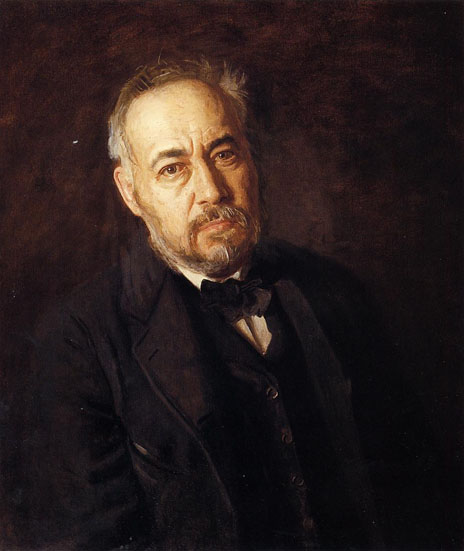
''No less important in Eakins' life was his work as a teacher. As an instructor he was a highly influential presence in American art. The difficulties which beset him as an artist seeking to paint the portrait and figure realistically were paralleled and even amplified in his career as an educator, where behavioral and sexual scandals truncated his success and damaged his reputation.''
Eakins occupies a classical position in the history of nineteenth century thought and art; that of the great man who saw too clearly in terms of the present to be acceptable to a public accustomed to thinking of greatness and beauty as prerogatives of the past, which therefore should be imitated. Thus, as a realist, Eakins appeared heavy and vulgar to a public that thought of art, and culture in general, largely in terms of graceful sentimentality. He seems to have recorded his fellow Americans with a perception that was both tender and vigorous, preserving an essence of life that he felt did not need to be supported by idealization. Yet, Eakins was not a modernist, at least by today’s standards since he did not revolt or reject against the past.
Throughout his life, Eakins ( 1844-1916 ) stayed on course as a ”scientific realist”, a term applied to him, although it is incomplete because it fails to indicate the warmth of spirit that suffuses his art.”His scientific interest in the human body led him to consider becoming a surgeon. Eakins then studied art in Europe from 1866 to 1870, notably in Paris with Jean-Léon Gérôme, being only the second American pupil of the French realist painter famous as a master of Orientalism. He also attended the atelier of Léon Bonnat, a realist painter who emphasized anatomical preciseness, a method adapted by Eakins. While studying at L’Ecole des Beaux-Arts, he seems to have taken scant interest in the new Impressionist movement, nor was he impressed by what he perceived as the classical pretensions of the French Academy.”
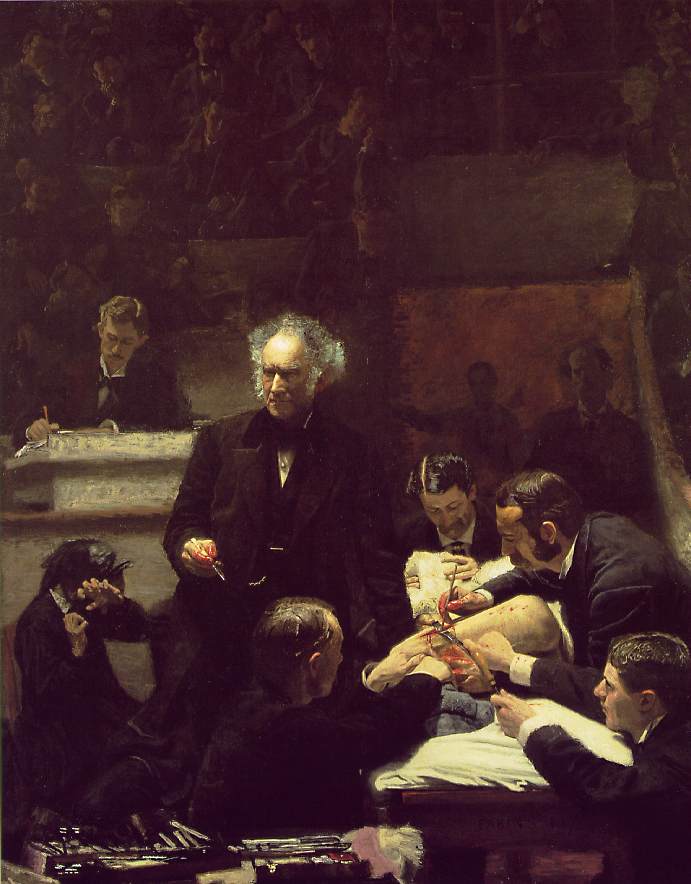
''The Gross Clinic'' The central figure of Dr. Samuel David Gross, and especially the powerful head, is more than an accurate portrait; it has become a symbol of the scientific intellect.
The nascent impressionism, in the early work of Manet, was a roaring scandal in Paris, but Eakins seems to have been indifferent to what was going on. During his youth, impressionism fought its battles and in his last years of life, cubism and Fauvism virtually changed the very definition of art. Yet, Eakins, seemed to live in isolation or was impervious to these movements.He is in a class apart, compared with other realists who shared his half of the century. Courbet loved opulance and theatrical effects which Eakins detested. Ditto as well to Daumier; this humanitarian employed realism to probe a socio-political system that held no interest for Eakins.
”Even Daumier, who had a vast love for people that included full recognition of their foibles, never presented them to us as individuals but only as generic types. Eakins, even when confronted by a set of features utterly indistinguished, always managed to reproduce those features with surface exactitude while exploring the character of the individual who lived behind them. …It was the ideal of the average individual as an independent, responsible unit in society.”
It is not surprising that some of the plain face people Eakins painted with such unyielding truth, were dissatisfied with the results and rejected their portraits, even though their posthumous reward is that they have been immortalized. John Singer Sargent, the most fashionable practitioner of portraiture in Eakins day, called this compromise with necessity to make a living; the subjecting of his talent to produce effigies that aimed to please he termed, ” a pimp’s profession”. Eakin’s was temperamentally incapable of flattery. By comparison, most of Sargent’s immortalizations resemble costume studies posed by manikins. Some of Eakin’s sitters, on the other hand, committed a form of posthumous suicide by paying for a portrait they hated and then burning it.
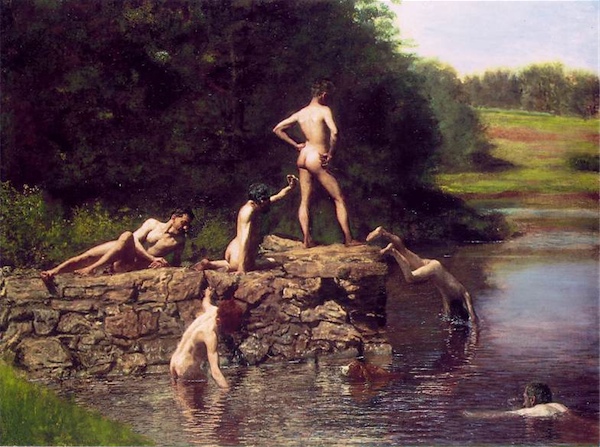
Eakins, The Swimming Hole. 1883. Nature for Eakins was not a picturesque spectacle but an integral part of daily life. He was the first American artist to reveal urban man's relationshipto nature other than sentimentality or nostalgically.
”It’s carefully composed but it hopes to be a glimpse of an everyday outing to a favorite swimming hole. It’s drawn, like much of Eakins’s painting, from photographic masters . It’s popular today to talk about Eakins and his work (and this one more than others) as homoerotic. That may well be. But not necessarily. It follows an obsession that Eakins had with the human body and its movement throughout his life; nearly all of Eakins works are in some way a study of the body, and his most famous works, the two clinic paintings, are studies of studies of the human body. He aspires to show it gracefully and naturally. And he also aims to provoke. He detests the prudishness of the Victorian age; its obsession with tightly fitting and uncomfortable clothing and its sense of shame over the
an body. “Eakins was a deep student of life, and with a great love he studied humanity frankly,” said his friend Robert Henri. “He was not afraid of what his study revealed to him.” His entire life was marked by controversy surrounding this point, and students who worked with him noted his preference for nudity—he posed for them and they posed for him. In this painting he presents himself in the right foreground in an almost voyeuristic pose.”
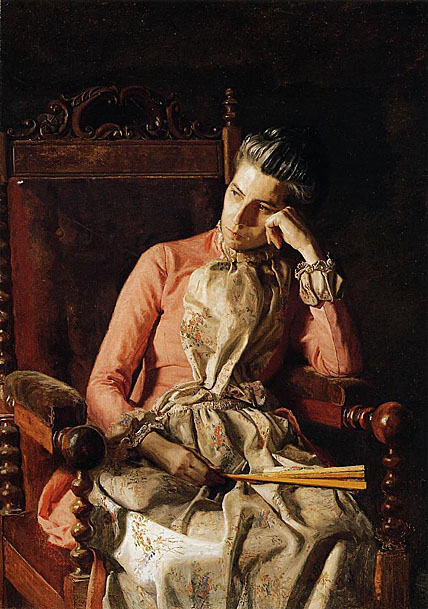
Amelia C. van Buren, (above ) was na artist who had been in Eakin's classes at the Pennsylvania Academy. He painted her in 1891, in the dark years after his rupture with that institution.
Eakin’s art can be called naturalistic only in relative terms, only in comparison with the swooning romanticism that distorted the natural appearance of objects in the service of an extremely personal vision. Eakins was a realist in the most profound sense; he was a sane, practical, and reflective man who found that the mere fact of the existence of the world was beautiful in itself. His passion for anatomy and perspective as the bases of representation was indeed scientific and objective. But anatomy for him was also, and primarily, a way of understanding the human body, which he loved as the most beautiful of all natural objects. And perspective was a means of distilling from nature the essence of a world that delighted him.
Eakins trouble with the public and his patrons came not because he painted in a way that people in general did not understand, but because he painted in a way that they understood perfectly. There was no question as to what he was saying or how he was saying it. He was speaking in clear language about familiar truths, but for this very reason he offended people who had become accustomed to the idea that the painter’s function was to speak in the debased language of the Salon, which confused truth with sentimental cliche’s.
In spite of their contrasting surfaces, Eakins and the impressionists were close kin. Both painted a bourgeois world that put its faith in mundane, practical values; and they embraced this everyday world and loved it for the way it looked, felt, tasted, sounded and smelled. Eakins may have belonged to the last generation of American artists for whom a truly indigenous expression was possible, except in the limited terms of naive folk art expression. The country’s increasing international power and international involvement, culminating in WWI, so changed its character that for an artist to be American in the way Eakins was American became impossible.
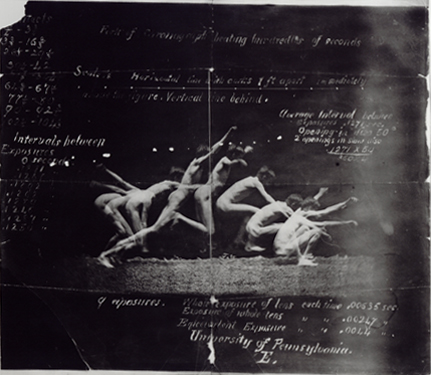
''Eakins was interested in what physiology could tell the artist about the body in motion. In 1884, he constructed a shed near Muybridge’s outdoor studio at the University of Pennsylvania, and modified a Marey-wheel camera to make chronophotographs of men running and jumping.''
”After 1918, Americanism-and the last syllable is the important one-could only be a form of isolationism, an artificial and reactionary attitude toward painting that had its temporary victory and final defeat in the regionalist art of the 1930′s, at the same time that a group of American politicians, the isolationists, were trying to make a walled island of the United States.”
Eakins grew up in the Civil War period and its aftermath. A time when European manners in art were still regarded as imported refinements that artists might aspire to, but an aspiration that was also a denial of more spontaneous and hence more specifically American way of expression. Eakin’s strength may lie in the fact he was not a prophet and not even interested in following the latest thing; experimentation and embellishment went against the grain of his vision which was rooted in a solidity, a trust in factual clarity and an unquestioning attitude toward the efficacy of traditional art forms.
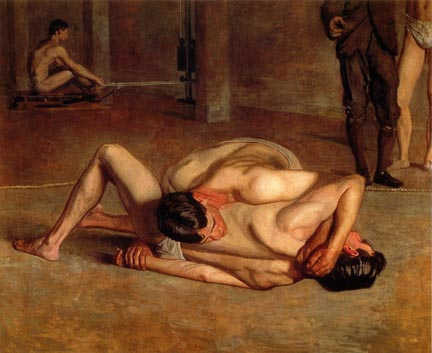
Eakins. The body to Eakins, is drawn, not as an object of artificial grace, but as an organism where beauty of form meant beauty of structural function.
Contemporaries like Courbet and Manet were purely artistic. An ”art for art’s sake” approach. That was the antipode to Eakin’s perception of the nude as a construction of parts joined in interdependence, moving with or against one another in perfect logic. Courbet’s nudes were more a glorification of flesh rather than structure, and Manet’s were a glorification of paint as something with its own existence and own reason for being; they both rejected a threadbare idealism for an immediate reference to the life around them.
Eakin’s realism ran counter to the tastes for prettiness and sentiment that had been inculcated into the part of society that commissioned portraits, as well as into the artists that served them, made up the juries and greased the wheel of art fortune. He sold very little, but gained recognition as a superb teacher, before a scandal resulting from his refusal to have male models covered with a loin cloth in front of female students led to his resignation in 1886 from the Pennsylvania Academy art school. By the 1890′s impressionism was seeping into America as the new movement, and was the default setting for young artists. Whistler, combining the appeal of delicate sentiment with a colorful personality and an easily assimilated modernism, became the idol of the social intellectuals.”But Sargent, all flash and high style, was king. When he came to Philadelphia as a lion, a hostess asked if there was anybody special he would like to see. There was only one man: Eakins. His hostess did not even recognize the name”.



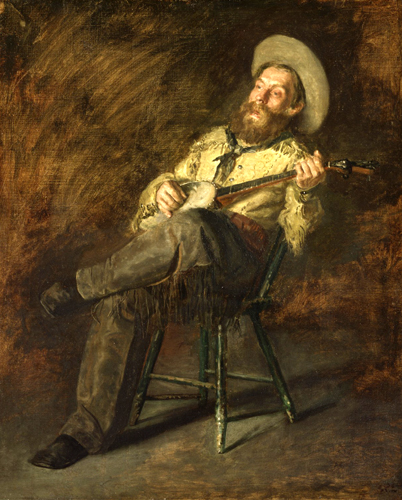
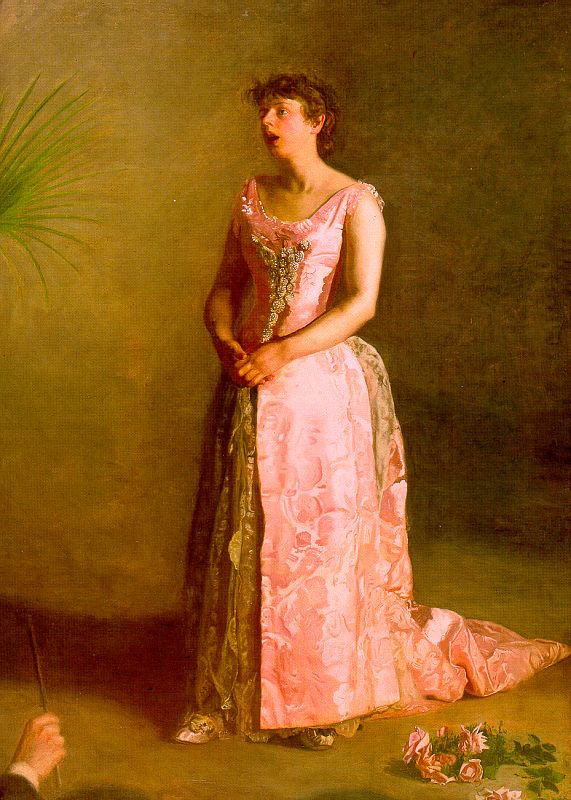





 COMMENTS
COMMENTS




I remember so many of these from when i was a teen. His stuff always transfixed me. Thanks for the write ups, especially the comparisons with others and the cultural historical contexts. I am old enough now to understand stuff i didn’t really grasp in my 20′s when most people otherwise would. Dr. Samuel David Gross is drawn very much like one (or perhaps a composite) professor(s) who, despite my limitations, were very very important to me. Strange today, actually feeling these memories in my body, but not today’s body altogether. Excellent Dave! Thanks, mason
I,ll get back to you a little later on this. go over my notes. you touched on something there; the incredible energy and spontaneity that the artist projected within a tradition and style of painting he was unwilling or felt unnecessary to question. Part of a lost America, neither pioneer or colonial, a mind space to reclaim without falling back on isolationism.
I hear you concerning the nature of the space and immediately grasp much more about dangers of falling back to isolationism. But, Lord, isolation & alienation (for that matter) have over run the american individual. No? If “we” do anything or express anything as a collective
I gather your notes are the links :-) I will Delve.
Thanks for very illuminating response!
-mason
Actually, my response was my notes, from memory.
If “we” do anything or express anything as a collective politically, socially or culturally these days it is terribly narrow.
What i was going to say. I had to attend to something and pushed “send” prematurely.
-mason